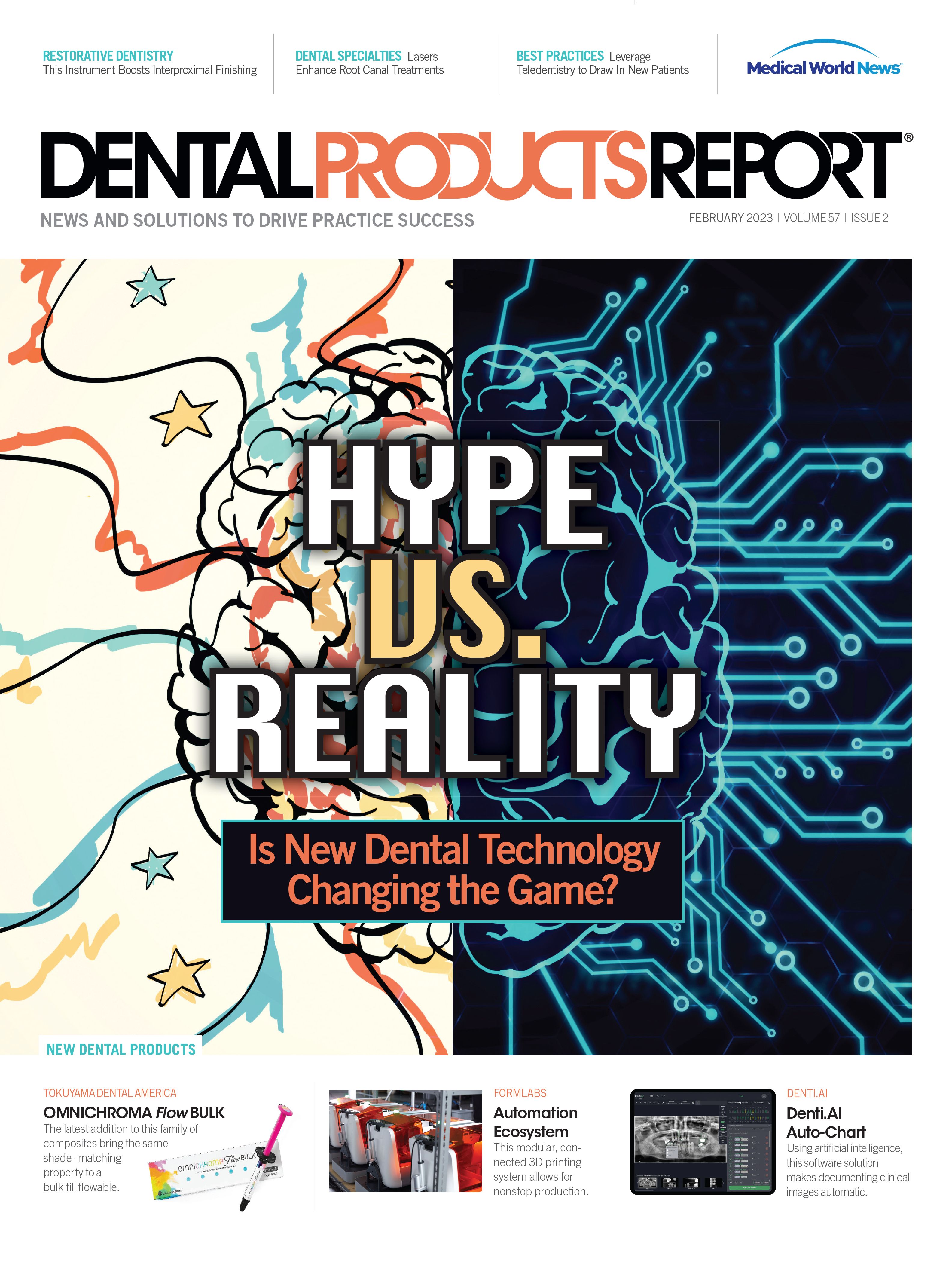Leveraging Teledentistry to Draw in New Patients Beyond COVID-19
Teledentistry served many dental practices during the COVID-19 pandemic, but it can be leveraged in a few ways beyond to serve clinicians and patients in the future.
Leveraging Teledentistry to Draw in New Patients Beyond COVID-19. Image courtesy of fizkes/stock.adobe.com.

The world of dentistry is progressing, and teledentistry is a huge part of that progression. For a practice to stay relevant in a quickly transforming market, it must implement virtual dentistry options. In October of 2019, DentaVox performed a survey where nearly 80% of respondents said they would use teledentistry within the following 5 years.1 This group was surveyed before the pandemic and the life changes that came with it. If the same survey was conducted today, how many more people would say they are likely to use teledentistry?
The pandemic completely transformed the healthcare industry. During the days of wearing masks and bulk buying hand sanitizer, the pandemic ushered in a new normal in all aspects of everyday life. This includes the way patients seek dental care.
The use of teledentistry increased significantly during the pandemic. Patients could discuss oral health concerns without leaving the safety of their homes. Teledentistry allowed patients to access safe dental care despite lockdowns and infection concerns. However, as lockdowns become less common and vaccines are distributed, patients don’t expect to stop virtual dental appointments. According to a survey done by GoodRx, only 12% of patients plan to stop virtual visits entirely.2
The rise of teledentistry may have started with the pandemic, but even as the world shifts slowly back to normal, teledentistry is here to stay. According to a survey by DentaQuest Partnership, 75% of dental providers currently using teledentistry expect the number of virtual visits at their practice to either stay the same or increase during the next year.3 Dental health professionals who have implemented teledentistry have seen the benefits and know this is what patients want. Patients today do everything online, from dating, buying groceries and more. They want the ease of the internet in everything they do, even dental appointments.
Patient Benefits
Teledentistry allows patients to have questions answered, photos exchanged, treatment plans explained, and in-person visits scheduled when necessary. Four groups of patients see the most benefits. These groups are:
- Working patients
- Teledentistry helps working patients because they don’t have to leave the office for an appointment. This helps them keep up with their dental care, even with their busy schedules.
- Children
- Children often struggle with dentist appointments. Some may struggle to sit still, and some may just be scared. Either way, when children are in pain, the last thing they want to do is go to the dentist. Virtual appointments allow dentists to see whether an in-person visit is necessary or if it can be treated at home.
- Patients with disabilities
- Patients with disabilities, both physical and mental, can often find it hard to go to the dentist. Teledentistry helps this group ensure they can treat dental issues as soon as they happen without leaving thehouse.
- Patients living in rural areas
- Patients living in rural areas may not have access to a dentist. If this is the case, their oral health is not taken care of the way it should be. Remote appointments can give them access to dental treatment that they otherwise wouldn’tget.
Treatments
Some dentists have concerns with teledentistry. Some complaints include inability to clean, no remote X-ray capabilities, and some diagnoses can only be done in-person. This is all true. In-person dental care is still essential to overall oral health. With teledentistry, this in-person care can be supplemented by virtual care that can help patients and dentists in many ways. Both in-person and virtual appointments should be used together to offer the best care to patients.
Teledentistry is not a replacement for all dental treatment, but some appointments don’t need to be done in person, allowing you to save chair space, time, and money. Teledentistry is good for emergency care, but it has many other applications as well. Patients have opted for virtual appointments for second opinions; questions about whitening solutions or clear aligners; concerns about lumps or white and red spots on their gums; and questions about vaping's effects on their oral health.
Practice Benefits:
Teledentistry benefits clinicians in many ways. It is profitable and efficient, provides intuitive software messaging, is easy to adopt, is HIPAA-compliant, improves case acceptance, new patient acquisition, and more. Some of the main benefits include:
- Cost Reduction
- Teledentistry reduces overhead because dentists don’t need personal protective equipment or other disposable tools. Virtual visits also lower turnover time because there is no need to clean in-between patients. This allows dentists to see more patients in less time without decreasing the quality of their care.
- Opportunity for Patient Education
- Teledentistry allows dental teams to educate patients without them even coming into the office. Remote appointments are great opportunities to give demos, dental advice, or product recommendations.
- Easy Aftercare
- After treatment, dentists can perform virtual follow-ups to ensure everything is progressing well and that no further treatment is needed.
- Second Opinions
- Virtual consultations make it easy for patients to visit multiple dentists and make the decision on which dentist and treatment plan they are most comfortable with. Virtual consultations make it easy for patients to test out a new practice, which can increase its business.
- More Time for Clinical Work
- Consultations, aftercare, and patient education take time. Doing these appointments remotely gives dentists more time to spend on clinical treatments.
- New Revenue Stream
- Teledentistry allows practices to reach new patients by expanding out of heavily saturated suburban markets to rural areas. With this added reach and the cost savings associated, teledentistry could be the next big revenue driver for a practice.
Teledentistry provides advantages for dental practices in a variety of ways. It is more affordable than in-office dentistry, offers more access to care for patients, reduce patients’ time away from the office, provides more in-office appointment for patients who really need them. All while providing the same level of care to patients as in-office visits.
Finding a Teledentistry Solution
Every practice should consider offering teledentistry to its patients. Teledentistry solutions can take several forms. Some platforms are standalone applications that manage teledentistry appointments but must be integrated into other applications and platforms a practice is running. Other teledentistry solutions are integrated into software platforms a practice might already be using.
One such case is the ProSites Virtual Consult tool that can be built into a practice’s website allowing online visitors the opportunity to choose the type of consult they need, list their concerns, and attach photos for evaluation.
Some features to look for from any teledentistry solution your practice is considering are the ability to:
- Code and bill virtual consults to insurance
- Upload patient media like photos and videos
- Triage emergency cases to prioritize care
- Integrate with your practice website and booking schedule
- Sort and filter cases by status or date
- Receive notifications about new communications
- Send video responses and patient messages
Whether we want to admit it or not, teledentistry isn’t going anywhere. By staying ahead of the curve and finding a trusted teledentistry provider to partner with, your practice will not only improve the quality of patient care you’re able to provide and build patient trust, but can also easily attract new leads, automate cosmetic leads, improve office efficiency with the ability to answer questions, order extra supplies, and build out a step-by-step plan before patients even sit in your chair.
References
- Petya I. Teledentistry: Survey Shows Patients Are Ready to Welcome It. Dentavox.Dentacoin. October 23, 2019. Accessed October 25, 2022. https://dentavox.dentacoin.com/blog/teledentistry-surteledentistry-survey-shows-patients-are-ready-to-welcome-it/
- Sasha G. The State of Telehealth, According to Healthcare Providers and Patients. GoodRx Health. November 15, 2021. Accessed October 25, 2022. https://www.goodrx.com/healthcare-access/telehealth/state-of-telehealth-survey-2021
- Rahul V. Future of Teledentistry in the Post-Pandemic World. Oral Health Group. February 22, 2021. Accessed October 25, 2022. https://www.oralhealthgroup.com/blogs/future-of-teledentistry-in-the-post-pandemic-world/
